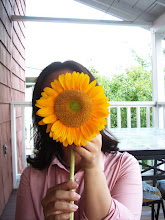
Last year, I found one of my friends had kkaennip plant. The discovery brought me back to my childhood. Some food probably took some degree of convincing (or desperation) for those had attempted to eat it for the first time in human history. Kkaennip, on the other hand, I don't think it was that hard. The smell of it is quite alluring. For me it is fragrance of summer!
I am from Seoul. I was born in south part of Korea, but raised in Seoul. It is a big city; a city with population of 24 million; one of the most crowded city in the world; city with skyscrapers and high technology. Most of people from Seoul would not remember any greenery or patch of garden outside of national parks located here and there. BUT I was lucky few who have lived in the area of Seoul without crowd and with lots green fields. I was running around fishing and foraging wild fruits with my friends. My neighborhood was about to be 'developed', so there was lots of empty fields and hills and ponds.
One day, I decided to be lady. Don't ask why. At the age of nine, I just decided that it would be cool to learn playing piano, drawing, and traditional calligraphy. Looking back, I still don't understand what inspired me.
During that summer, I was going back and forth between activities of my liking. It was short walk from my house to the piano and art class. My mother, as any other parents in Korea did, let me walk by myself. Around my neighborhood, every one knew everyone back then. So it was quite natural for us (me and my friends) to run around by ourselves.
I dropped by one house to greet the little puppy liked me and always was excited to see me. I wondered around little bit chasing white little butterflies in the open garden. Among this, I liked one patch of land most.
It was big (for my eyes, at least) fragrant green sea. Endless rows of kkaennip with their gorgeous thick fragrance and yellow Korean pumpkin blossoms picking out around the edge of garden.
With sweltering summer heat, the air was thicken with the smell of refreshing kkaennip. It was like opening hot pot of stew, which fresh kkaennip was just added. It was clean and refreshing smell. There was always an old lady, sitting under the parasol, chatting with her friends where the edge of the garden met the pedestrian side of street, . Occasionally a customer would show up asking her to get some of kkaennip or other vegetable she grew. She did not have anything on display. Whenever asked, the old lady with cheerful smile would get up, walked into her garden, harvested whatever the customer asked and some more, and sold them with a exchange of small money. I was fascinated the smell of it. After all, it was my favorite vegetable. The kkaennip and other small vegetable gardens and the ponds were there till my senior high school years. One day, coming back from school, I discovered to my horror all were gone replaced by big construction site. Irony is, my home in Korea is now one of the big condominium complex built during that time, facing directly where my favorite garden was.
After I came US for study, there were so many greens I miss including kkaennip. It is not so hard to get but too expensive for poor graduate student budget. I couldn't believe the price tag!!! So discovery of my friend with kkaennip garden was like ten Christmas combined all together! She was more than happy to let me have some of plants, for seed. And this year I am having garden fever. Like all other proud parent (of child, pat, and plants), I photograph them every day.
 Here, they were just peeking out in cold April Boston morning!
Here, they were just peeking out in cold April Boston morning!
Look! Now they are looking like kkaetnnip!
Every day, I picture various things I can do later with the harvest! I become the owner of perillar garden, like the old lady in my memory (though I am way younger then she was). I can not wait to make kimchi with it. Or simply roll steamed rice mixed with other grains, specially barley with Korean bean paste!!!
Fresh kkaennip has after taste of mint. well, after all, kkaennip is a member of Perilla frutescens which belongs mint family.
Almost all northeast and southeast Asian country have their own perilla. Japan has Shiso which used widely from in soups to coloring umeboshi, pickled plum dish. In China, it is 紫蘇 which used as medicine and in Vietnam tía tô used in various dish. Each has very different taste, even though they are in same family.
Like Italian parsley, kkaennip is used here and there to add fresh taste in otherwise heavy tasting dish. The seed is used as condiment or for oil. The cake after extracting oil made excellent animal feed and compost.
Some Korean cookbooks and recipes (including mine) refer kkaennip as sesame leaf, despite it has nothing to do with sesame plant. The reason, I guess, is that the seed of perilla is called deulkkae which literal translation would be 'wild sesame' even though botanically sesame and perilla is not related.
Speaking of garden fever, I was so inspired by kkaennip, I decided to let them have some company. So here it (or they) goes!

I now grow snowpea, basil, mint, mustard green, lettuce, Korean cucumber, kkwari chili pepper and still debating, yes you guessed, growing tomatos.


